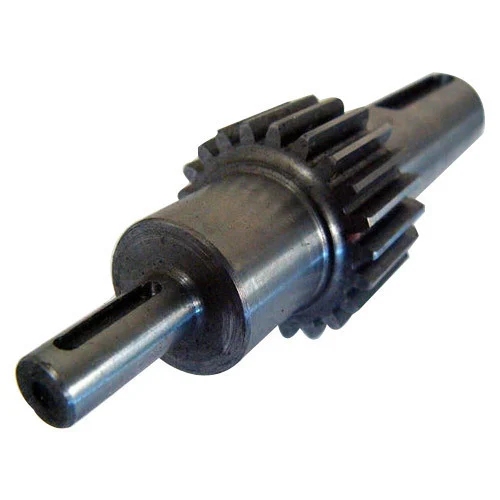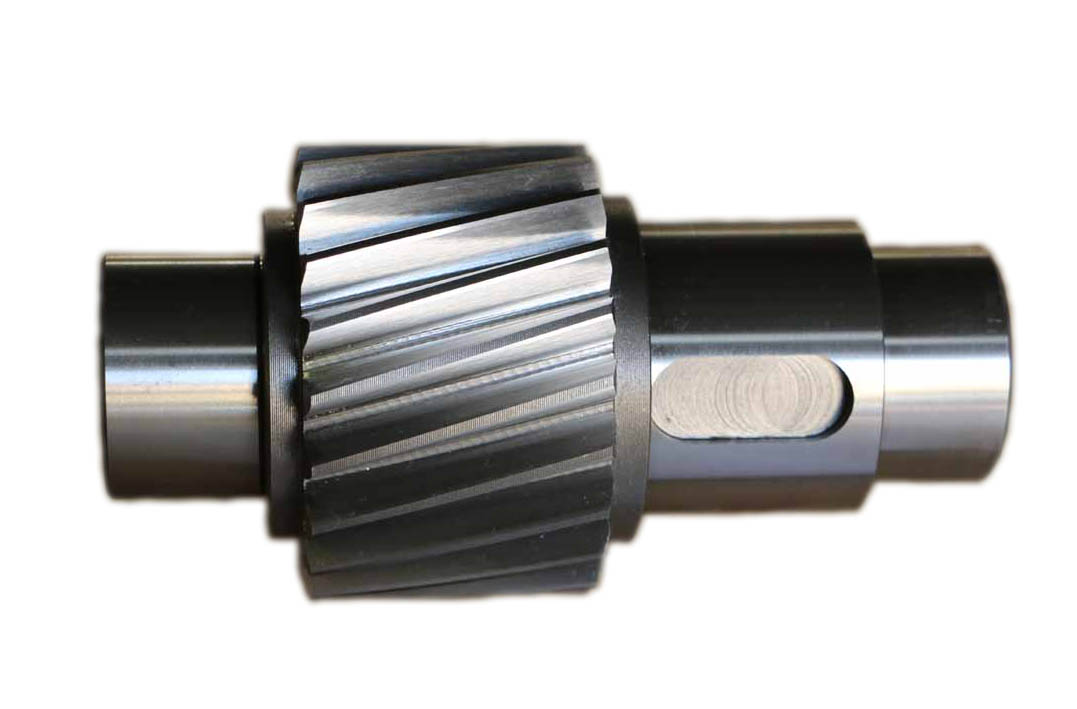Product Description
Forging Shaft/gear shaft/drive shaft/spline shaft/propeller shaft/transmission shaft
CIC is a more than 30 – year manufacturer and reputed supplier of forged shaft used in various machinery equipment in the fields of mining, metallurgical, chemical industry, construction, and so on. CIC possesses professional design team, advanced equipment and detecting method, strict quality control system to meet all your customized requirements of forged shaft. High quality, excellent performances and competitive price will make you rely on us and choose us.
CIC has manufactured many kinds of forged shafts, including forged roller, forged support roller shafts, forged thrust roller shafts, forged pinion shaft with gears both mounted to the shaft and as a part of the shaft, and other more kinds of forged shafts.
Bring us your challenges, and we will deliver solutions.
Features:
1. Material: stainless steel, carbon steel, alloy steel and as your requests
2. Standard: Standard: ANSI, API, ASTM, BSI, DIN, GB, ISO, JIS and more standards.
3. Mechanical Properties: customized requirements are accepted.
4. Hardness: customized requirements are accepted.
5. Surface treatment: rust preventive oil and according to your requirements.
6. Application: mainly used in various machinery equipment in the fields of mining, metallurgical, chemical industry, construction, and so on
7. QA and DOC: chemical composition report, mechanical properties report, UT report, PT report, heat treatment report, dimensions check report, hardness report and more
We can offer third party inspection.
8. Process: raw material purchasing – casting- rough machining – heat treatment – semi machining – finish machining – shrinkage fitting – painting and packing
Various process conditions are available.
9. Certificates: ISO 9001:2008
10. Products ability: Max length: 20m, Max OD: 2m
11. Heat treatment: quenching and tempering, normalizing and tempering.
12. QC: fabrication schedule, fabrication process chart, inspection and test plan
13. Packing: coated with rust preventive oil, seaworthy packing
Advantages:
1. More than 30 years experience
2. ISO9001:2008 Standard certified
3. Custom-made design
4. All seamless forged
5. Strict quality control
6. Prompt delivery
Main Manufacturing Machines:
2×8m Numerical Controlled Horizontal Lathe
6×20m heavy Horizontal Lathe
200 Numerical Controlled Boring& Milling Machine
| Application: | Excavator, Lawnmower, Tractor, Ke Tan, Boat, Motorbike, Truck, Car |
|---|---|
| Certification: | TS16949, ISO 9001, CE |
| Warranty: | 12 Months |
| Engine Type: | Diesel |
| Material: | Cast Iron |
| Name: | Super Shaft |
| Customization: |
Available
| Customized Request |
|---|

Can you explain the impact of gear shaft misalignment on gear performance?
Gear shaft misalignment can have a significant impact on the performance of gears within a system. When gear shafts are not properly aligned, several issues can arise, affecting the overall functionality and reliability of the gears. Let’s explore the impact of gear shaft misalignment in detail:
- Reduced Efficiency:
Misalignment causes a loss of efficiency in gear systems. When gear shafts are misaligned, the teeth of the gears do not mesh correctly, leading to increased friction and energy losses. This results in reduced power transmission efficiency, as a portion of the input power is dissipated as heat instead of being effectively transferred through the gears.
- Increased Wear and Fatigue:
Misalignment can lead to uneven contact and loading between gear teeth. This uneven distribution of forces causes localized high-stress areas on the gear teeth, leading to accelerated wear and fatigue. The concentrated stress on specific areas of the teeth can result in pitting, wear, and even tooth breakage over time. Increased wear and fatigue significantly reduce the lifespan of gears and can lead to unexpected failures.
- Noise and Vibration:
Gear shaft misalignment often results in increased noise and vibration levels within the gear system. As the misaligned teeth engage, they generate excessive noise due to impact and increased friction. The vibrations caused by the misalignment can propagate through the gear assembly and the surrounding components, causing additional noise and potentially affecting the performance and lifespan of the entire system.
- Loss of Tooth Contact:
Misalignment can cause a loss of proper tooth contact between the gears. Insufficient tooth contact reduces the load-carrying capacity of the gears and compromises the transmission of torque. The reduced contact area also increases the likelihood of localized stress concentrations, leading to premature wear and failure.
- Overloading and Unbalanced Loads:
Gear shaft misalignment can result in overloading and unbalanced loads on the gears. Misalignment can cause uneven distribution of forces, with some teeth bearing a higher load than others. This can lead to excessive stress on specific gear teeth, potentially exceeding their load-carrying capacity. Over time, the overloading of certain teeth can result in accelerated wear, tooth breakage, and even catastrophic gear failure.
- Seal and Bearing Issues:
Misalignment can also affect the performance of seals and bearings within the gear system. Misaligned gear shafts can create additional radial or axial loads on the bearings, reducing their lifespan and causing premature failure. Seal integrity can also be compromised, leading to leaks and contamination of the gear system, further exacerbating the issues associated with misalignment.
In summary, gear shaft misalignment has a detrimental impact on gear performance. It reduces efficiency, increases wear and fatigue, generates noise and vibration, causes loss of tooth contact, leads to overloading and unbalanced loads, and affects the performance of seals and bearings. Proper alignment of gear shafts is crucial to ensure optimal gear performance, longevity, and reliable power transmission within the gear system.

What are the advantages of using a gear shaft in various gear arrangements?
A gear shaft offers several advantages when used in various gear arrangements within mechanical systems. It plays a critical role in transmitting motion and power efficiently. Here are the advantages of using a gear shaft:
- Mechanical Power Transmission:
A gear shaft enables the transmission of mechanical power between gears in a gear arrangement. By connecting and meshing with multiple gears, the gear shaft efficiently transfers rotational motion and torque from the driving gear to the driven gear. This power transmission capability allows for the amplification, reduction, or redirection of power as required by the mechanical system, enabling the efficient operation of machinery and equipment.
- Speed and Torque Conversion:
With the use of different gear arrangements on a gear shaft, it becomes possible to convert speed and torque. By employing gears with different numbers of teeth or gear ratios, the rotational speed and torque output can be adjusted. Gear arrangements like spur gears, helical gears, bevel gears, and planetary gears on the gear shaft allow for precise speed and torque conversion, enabling the adaptation of mechanical systems to specific requirements.
- Mechanical Advantage:
A gear shaft offers the advantage of mechanical advantage. By incorporating gears with different sizes or gear ratios, the gear shaft can provide mechanical advantage in terms of torque amplification or speed reduction. This allows for the efficient utilization of available power and the optimization of mechanical system performance. Mechanical advantage is particularly beneficial in applications where high torque or precise speed control is required.
- Versatility and Flexibility:
The use of a gear shaft provides versatility and flexibility in gear arrangements. Different types of gears can be mounted on the gear shaft, allowing for the creation of complex gear systems. Gear arrangements can be customized based on the specific requirements of the mechanical system, such as space constraints, torque demands, and speed ranges. The gear shaft’s versatility enables the implementation of various gear combinations, making it adaptable to a wide range of applications.
- Smooth and Reliable Operation:
When properly designed and manufactured, a gear shaft ensures smooth and reliable operation of the gear arrangement. The gear teeth on the gears mesh with precision, guided by the gear shaft, resulting in minimal noise, vibration, and backlash. The gear shaft’s stable and accurate rotation facilitates the synchronized movement of gears, promoting efficient power transmission and reducing wear on the gear teeth. This contributes to the overall longevity and reliability of the mechanical system.
- Durability and Load Capacity:
A gear shaft, constructed from durable materials and designed to handle high loads, offers excellent durability and load-carrying capacity. The gear shaft’s robust construction allows it to withstand the forces and stresses encountered during power transmission. It ensures the gear arrangement can handle the required torque, resist deformation, and maintain its integrity under demanding operating conditions.
In summary, the advantages of using a gear shaft in various gear arrangements include mechanical power transmission, speed and torque conversion, mechanical advantage, versatility and flexibility, smooth and reliable operation, durability, and load-carrying capacity. Gear shafts are essential components that enhance the performance, efficiency, and reliability of mechanical systems.

What industries commonly use gear shafts in their applications?
Gear shafts find applications in various industries where the transmission of motion and power is necessary. They are widely utilized in numerous sectors that rely on machinery and mechanical systems. Here are some industries that commonly use gear shafts in their applications:
- Automotive Industry:
The automotive industry extensively uses gear shafts in vehicles. Gear shafts are present in the transmission systems, where they transmit power and torque between the engine and the wheels. They enable gear shifting, torque conversion, and speed control, contributing to the overall performance and drivability of automobiles.
- Industrial Manufacturing:
Industrial manufacturing sectors, such as machinery manufacturing, rely heavily on gear shafts. They are used in various types of machinery, including lathes, milling machines, conveyor systems, and assembly lines. Gear shafts enable power transmission, motion control, and torque conversion in these machines, facilitating the production and processing of goods.
- Aerospace and Defense:
In the aerospace and defense industries, gear shafts are crucial components in aircraft engines, helicopters, and military vehicles. They play a vital role in transmitting power and torque between the engines and propellers or rotors, providing the necessary thrust and control. Gear shafts in these applications must meet stringent performance and reliability requirements.
- Power Generation:
Gear shafts are utilized in power generation industries, including thermal power plants, hydroelectric plants, and wind turbines. They facilitate the transfer of rotational motion and torque from turbines or generators to power transmission systems. Gear shafts in these applications often handle high-power outputs and must be designed to withstand demanding operating conditions.
- Construction and Mining:
The construction and mining industries commonly employ gear shafts in heavy machinery and equipment. Gear shafts are found in excavators, bulldozers, cranes, and drilling rigs, among others. They enable power transmission and torque conversion, allowing these machines to perform tasks such as digging, lifting, and drilling with precision and efficiency.
- Marine and Shipbuilding:
Gear shafts are essential components in marine applications, including ships, boats, and marine propulsion systems. They are utilized in marine engines, propellers, and thrusters, enabling the transmission of power and torque for propulsion and maneuvering. Gear shafts in marine environments must be corrosion-resistant and capable of withstanding the harsh conditions of saltwater and vibrations.
- Renewable Energy:
In the renewable energy sector, gear shafts are used in wind turbines and solar tracking systems. They facilitate the transfer of rotational motion and torque from wind or solar power sources to generators or energy storage systems. Gear shafts play a vital role in converting and optimizing the energy generated from renewable sources.
These are just a few examples of industries that commonly use gear shafts in their applications. Gear shafts are versatile components that are integral to the functioning of machinery and mechanical systems across various sectors.


editor by CX 2023-12-13